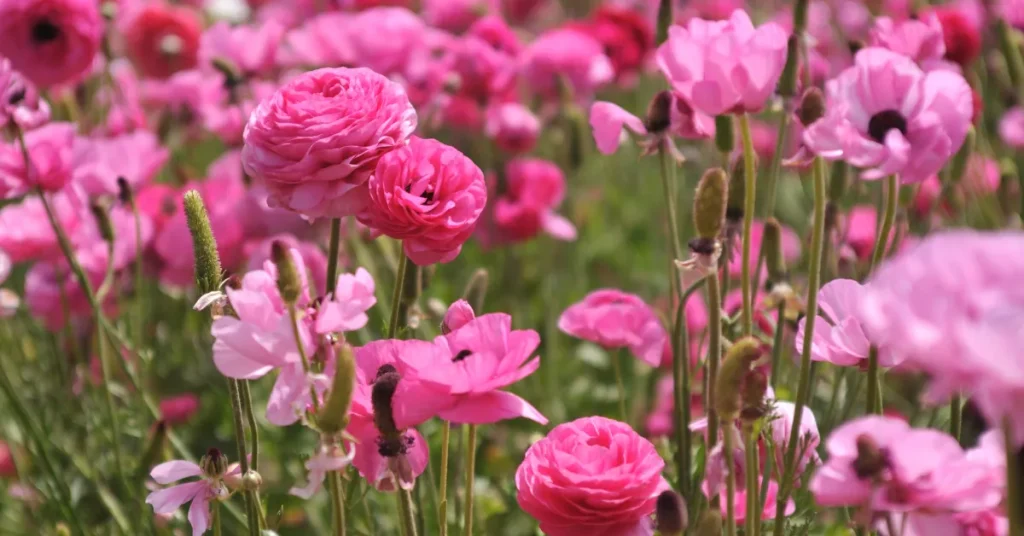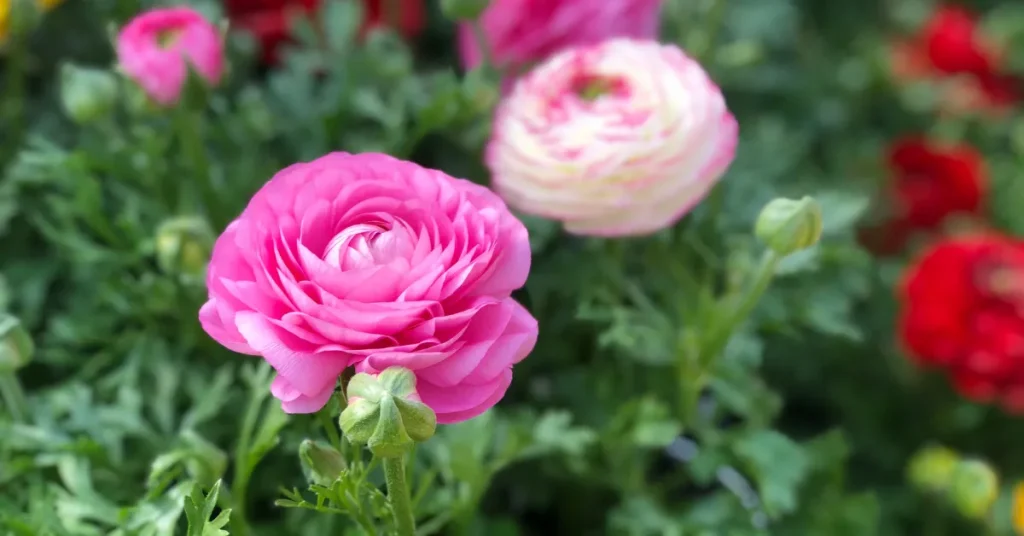Plant Ranunculus bulbs 1-2 inches deep, spacing them about 4 inches apart. Ensure they’re in a sunny spot with well-draining soil for optimal growth.
Ranunculus are flowering bulbs prized for their vibrant, rose-like blooms that brighten gardens in the spring. These colorful perennials are perfect for borders, pots, and as cut flowers, enchanting gardeners with a spectrum of hues.
To thrive, they require a little preparation; choosing the right depth and spacing is crucial for their success.
With a proper start, these hardy blooms will reward you with lush, intricate petals and a long flowering period. By delivering just the right depth, your garden will soon host a dazzling display of these beloved blossoms.

Preparing The Garden For Ranunculus
Cultivating ranunculus starts with a garden space that nurtures their growth. With their vibrant blooms, ranunculus are a springtime favorite among gardeners.
Proper garden preparation ensures a bounty of colorful flowers. Let’s prepare the ideal bed for these beauties.
Choosing The Right Location
Location matters for ranunculus. They thrive in spots with full sunlight. This means at least 6 hours of direct sun daily. Pick a spot away from larger plants. Big plants might cast shadows, robbing these sun-lovers of vital rays.
Soil Requirements For Healthy Growth
Well-draining soil ranks high for ranunculus. They dislike wet feet. Rich, loamy soil with a pH balance between 6.0 and 7.0 is ideal. Consider these soil amendments:
- Compost: Adds nutrients.
- Perlite or sand: Improves drainage.
- Bone meal: Fosters root development.
Test the soil to tailor amendments to your garden’s needs. This step should not be overlooked.
Selecting Quality Ranunculus Corms

Choosing the best ranunculus corms is essential for a vibrant and healthy bloom. Quality corms are the foundation of a successful ranunculus garden.
Understanding how to pick the right ones can seem daunting, but with a few clear tips, gardeners can plant with confidence.
Identifying Healthy Corms
Healthy ranunculus corms are your garden’s future stars. Look for firmness and avoid any that are soft or show signs of rot. A good corm has a rounded, plump shape and a light brown hue.
Small size does not necessarily mean poor quality; even tiny corms can produce stunning flowers if they are firm and healthy.
- Feel for firmness and avoid soft textures
- Examine for uniform, light brown color
- Inspect for any signs of mold or decay
Best Varieties For Stunning Blooms
Ranunculus come in many varieties that produce captivating colors and impressive blooms. For the best result, consider these top performers:
| Variety Name | Bloom Color | Bloom Size |
| La Belle | Pastel shades | Large |
| Tecolote | Vibrant hues | Extra-large |
| Butterfly Ranunculus | Varied colors | Medium with unique shape |
Choose varieties well-suited to your climate for the best growth and display. Pairing the right variety with quality corms is key to a breathtaking ranunculus showcase in your garden.
The Ideal Planting Depth Explained
Getting the planting depth right for ranunculus bulbs leads to vibrant blooms. Not too deep, not too shallow; it’s about finding that sweet spot. Here’s a guide to ensure you plant your ranunculus at the ideal depth every time.
Measuring For Perfect Depth
Begin with the right tools. Use a ruler or a measuring stick. Ranunculus bulbs, also called corms, should sit about 1-2 inches under the soil’s surface. For reference, that’s roughly the size of a corm across.
Follow these steps:
- Dig a hole. Make it 1-2 inches deep.
- Place the corm. The claws, or roots, should face down.
- Cover with soil. Use loose, well-draining soil for best results.
Consequences Of Incorrect Planting Depth
Planting too shallow or too deep can cause problems for ranunculus. If planted shallowly, the corms may not root properly, leading to poor growth. Too deep and they may not emerge at all.
Signs of improper depth include weak stems, few flowers, or no growth. Regular checks ensure corms sit perfectly in the soil.
Correct depth equals full, healthy blooms. Armed with this knowledge, your garden is set to burst with color.
Timing Matters In Planting Ranunculus
Planting ranunculus at the right time ensures blooms that turn heads and grace gardens with colors galore. Think of timing as the secret ingredient to your flower-growing success.
Seasonal Considerations
Spring and fall are pivotal seasons for planting ranunculus. In zones with mild winters, aim for fall planting. This allows the bulbs, known as corms, to establish roots. Those with harsh winters should opt for early spring, after the frost has passed.
- Fall: Zones 8-10
- Spring: Zones 4-7
Temperature And Climate Factors
Ranunculus flourish in cooler temperatures between 50°F and 60°F. Planting is best when soil temp doesn’t exceed 55°F. Be vigilant, as high heat or frost can damage the corms.
| Climate | Planting Depth | Notes |
| Mild Winter | 2 inches | Bulbs establish over winter |
| Harsh Winter | Not applicable | Wait for spring thaw |
Post-planting Care For Maximum Blooms

Now that your ranunculus bulbs are snuggled into their beds, it’s time to ensure they burst into a dazzling display of blooms. Post-planting care is essential for maximum blooms.
Proper watering, fertilization, and protective measures can make all the difference. Let’s dive into the techniques that will foster vibrant and healthy ranunculus flowers.
Watering Techniques
Ranunculus plants love moisture, but they despise soggy feet. This delicate balance is key to their success.
- Water ranunculus after planting until soil is moist.
- Avoid waterlogged soil to prevent bulb rot.
- Once leaves appear, reduce watering, allowing the topsoil to dry between watering sessions.
- Use a drip irrigation system or water at the base to keep foliage dry and prevent mildew.
Fertilization And Nutrition
To bloom, ranunculus need the right nourishment. Let’s feed these beauties for a brilliant show.
- Start with well-draining soil enriched with organic matter.
- Apply a balanced slow-release fertilizer at planting time.
- Replenish nutrients with a monthly dose of high-phosphorus fertilizer to promote blooms.
Protecting From Pests And Diseases
Healthy plants have the best defense. Ranunculus can be bothered by a few pests and diseases.
| Pest/Disease | Signs | Prevention/Treatment |
| Aphids | Sticky residue on leaves | Spray with water or use insecticidal soap. |
| Fungal Diseases | Spots on leaves | Ensure good air circulation and avoid overhead watering. |
| Snails/Slugs | Chewed leaves | Use barriers like crushed eggshells or diatomaceous earth. |
Check plants regularly and act quickly at any sign of trouble. This proactive approach will keep your ranunculus thriving and ready for a spectacular bloom season.
Common Mistakes To Avoid
Planting ranunculus seems straightforward, but some enthusiasts trip over common pitfalls. Avoid these mistakes for a successful bloom.
Over Or Under Watering
Ranunculus love moisture, but balance is key. Too much water leads to rot, while too little stunts growth. An initial soak is essential. After that, let the top soil dry before watering again. Use a simple touch-test to determine moisture levels.
Ignoring Soil Ph
The right pH level can make or break your ranunculus’ growth. These flowers thrive in slightly acidic soil. Aim for a pH between 6.0 to 6.5. Use a pH meter to monitor levels. Adjust with sulfur or lime if necessary, based on your readings.
Neglecting Spacing And Crowding
Dense planting might yield more blooms, but this strategy can backfire. Too close, and your ranunculus will compete for resources.
This weakens the plants and may encourage disease. Ideally, space tubers about 4 inches apart. This ensures adequate air flow and nutrient availability.
FAQs About How Deep To Plant Ranunculus
What Is The Ideal Depth For Ranunculus Bulbs?
Ranunculus bulbs, also known as corms, should be planted about 1 to 2 inches deep. Ensure the “claws” of the corms face downwards. Planting at this depth allows for adequate root development and anchorage.
How Far Apart To Space Ranunculus When Planting?
Space ranunculus corms approximately 4 to 6 inches apart. This spacing allows for ample growth room, adequate air circulation, and prevents overcrowding which can lead to disease.
Can You Plant Ranunculus In Spring?
Yes, you can plant ranunculus in spring. However, in cooler climates, it is advisable to start them indoors 6 to 8 weeks before the last frost date for an earlier bloom.
What Soil Conditions Favor Ranunculus Growth?
Ranunculus thrives in well-draining soil rich in organic matter. A slightly acidic to neutral pH, between 6. 0 and 7. 0, is also preferable for optimal growth and flowering.
Conclusion
Mastering the proper depth for planting ranunculus is key to a flourishing garden. Aim for a depth of about 1. 5 to 2 inches, ensuring good root establishment without suffocating the bulbs. With the right care and depth, expect a vibrant display that heralds the beauty of spring.
Happy gardening!
Resources:
1. https://plants.usda.gov/DocumentLibrary/plantguide/pdf/pg_raoc.pdf
